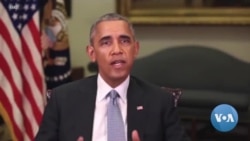U.S. government officials and technology experts are sounding the alarm about a new social media threat: Fake videos of political leaders and candidates for office.
They are known as “deepfakes,” synthetic videos that use artificial intelligence to combine images into a convincing illusion, like having a well-known person say something they never said.
In the technology’s infancy just a few years ago, the flaws in deepfakes were evident to most viewers. But experts warn that rapid advances have already made the difference between real and synthesized voice imperceptible and that it may be just a matter of months before reaching the same point with video.
In the U.S., fears are mounting that deepfake technology could cause disruption as people head to the polls.
Lawmakers have proposed legislation aimed at preempting the threat. Facebook, Google, YouTube and Twitter have updated their policies, saying they will remove deepfakes designed to deceive voters.
But first they will have to find them.
Teaching an AI to spot deepfakes
A digital arms race is underway, to design technological tools to identify deepfakes.
One leader in this effort is Hany Farid, a digital forensics expert at the University of California, Berkeley. His lab receives funding from both the Defense Advanced Research Projects Agency (DARPA) and Facebook. He is focusing his efforts on the facial gestures of current U.S. presidential candidates.
“We have pretty consistent mannerisms, the way we talk,” says Farid. “We’ve been building what we call soft bio-metric models.” These gestural models, as unique to a person as their fingerprints, are made by feeding hours of video of each candidate into a computer system.
Farid is preparing for a scenario in which a malicious deepfake of one of the candidates appears in the final days of the election.“
Our hope is to make this technology available to mainstream journalists and then allow them, as videos start to hit, to authenticate them or not,” he says.
The San Francisco-based AI Foundation is also joining the detection effort. The tech startup actually builds synthetic personalities it considers beneficial, like a Deepak Chopra AI you can interact with via smart phone. But then it also shares detection tools.
“We want to recognize the potential harm in the kinds of technologies that we are creating,” says Delip Rao, director of research at the AI Foundation, which is a hybrid for-profit/non-profit organization.
The foundation is launching a platform called Reality Defender, combining detection tools from researchers across industry and technology that the public will be able to use.
“This is going to be our Manhattan Project, to fight misinformation,” says Rao.
New bans still allow deceptive video
Farid says that Facebook’s new policy on deepfakes is too narrowly-defined and fears that other forms of political disinformation will still flourish on the site.
Many experts point out that the Facebook ban would not have applied to a clip of U.S. House Speaker Nancy Pelosi with altered speech that went viral last year. The clip, and others in a category known as “cheapfakes,” are easily made with common editing software. The Pelosi video, which falsely labeled the congresswoman as “drunk,” received over 2.2 million views in its first 48 hours on Facebook.
Recently, Pelosi asked Facebook and Twitter to take down another doctored video showing she ripped up President Donald Trump’s State of the Union speech while he was speaking. Both Facebook and Twitter declined.
As primary season begins, there’s a lot at stake. Consumers of online media may have the most important role in stopping the spread of synthetic disinformation, Farid says.
“It's not just an issue of deepfakes,” he says. “It's not just an issue of Facebook falling asleep at the wheel. And it's not just an issue of a polarized society. It's all of them coming together that I think is leading to issues that are existential threats to our democracy.”







